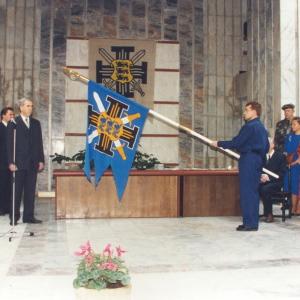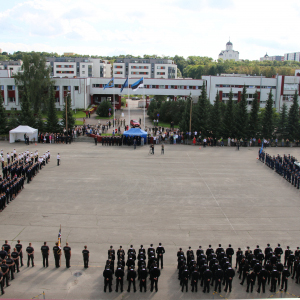A pressing need emerged when the Estonian independence was restored – we had no educational institution to provide higher education for police officers and other internal security service officials. Similarly, the recently established Estonian Defence Forces were concerned about the scarcity of officers.
Establishing two higher education institutions – one for internal security and the other for defence forces – at the same time was clearly too much for the young state. It was thus decided to establish a joint school for training officers for the police, customs, pre-trial investigation, detention centres, border guard and rescue service as well as defence military personnel. Such a combination of specialities was unique. The idea was further developed by professor of law Eduard Raska who also became the school’s first rector.
The Government of Estonia established the Estonian Academy of Security Sciences on 15 April in 1992. The school was given the facilities of the Soviet Higher Military-Political Construction School in Maarjamäe where it is located to this day. The instruction began on 12 October with altogether 185 students enrolled at the specialities of police service, investigation, customs, corrections, border guard and defence forces.
In 1993, it was renamed as the Estonian National Defence Academy. In 1998, the speciality of population management was opened and the College of Administration created accommodating also the speciality of customs.
In 1999, the Government of the Republic of Estonia decided to terminate the training of military officers at the academy transferring it to the new Estonian Military Academy in Tartu. In the same year, the speciality of population management was replaced with public administration, with the speciality of assistant judge introduced in 2001 and the speciality of taxation in 2002. In 2004, the Väike-Maarja Rescue School joined the Academy’s Rescue College and the Paikuse Police School joined the Police College. A year later, Civil Service Training and Development Centre was established at the academy. In 2005, the vocational education programme for prison officers was transferred from Tallinn Pedagogical Seminar to the Academy. In the autumn of 2006, the Muraste Border Guard School was merged with the Academy’s Border Guard College with a new unit created in the structure of the academy – Service Dogs Training Centre.
In 2004, the Väike-Maarja Rescue School joined the Academy’s Rescue College and the Paikuse Police School joined the Police College. A year later, Civil Service Training and Development Centre was established at the academy. In 2005, the vocational education programme for prison officers was transferred from Tallinn Pedagogical Seminar to the Academy. In the autumn of 2006, the Muraste Border Guard School was merged with the Academy’s Border Guard College with a new unit created in the structure of the academy – Service Dogs Training Centre.
Since 2010, there have been four colleges in the academy: the Financial College, the Prison Service College, the Rescue College and the Police and Border Guard College. Among the new units created were also the Internal Security Institute providing Master’s studies, the Centre for Innovative Applied Learning Technologies (merged with the Department of Development in 2016), and the Centre for Migration Studies (with its activities transferred to Tallinn University in 2015). In 2016, the Civil Service Training and Development Centre was closed and the respective functions transferred to the Ministry of Finance. The Centre for Legal and Social Sciences, created on the basis of the Centre for General Subjects, was merged with the Internal Security Institute in 2016. Continuing education is coordinated by the Centre for Continuing Education.